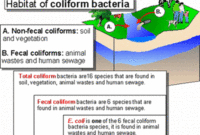International epidemiological studies have shown that E. coli and enterococci are more specific indicators of human health risk from recreational contact with fresh water and saline water than faecal coliforms.
E. coli and enterococci are members of the two bacteria groups, coliforms and faecal streptococci, respectively, and are used as indicators of possible sewage contamination because they are commonly found in human and animal faeces. Although they are generally not harmful themselves, they indicate the possible presence of pathogenic (disease-causing) bacteria, viruses, and protozoans that also live in human and animal digestive systems. Therefore, their presence in water bodies suggests that pathogenic microorganisms might also be present and that swimming and eating shellfish might be a health risk.

E. coli is relatively straightforward and inexpensive to measure. It can survive for up to four to six weeks in freshwater and is a definite indication of recent faecal contamination. While it is not possible to know whether E. coli are of human, animal or avian origin, all of these species can act as carriers of micro-organisms that can cause human disease. The chances of E.coli multiplying in water are very small, except under some specific tropical and sub-tropical conditions, so the number detected can be interpreted quantitatively.
Enterococci are distinguished by their ability to survive in salt water, and in this respect they more closely mimic many pathogens than do other indicators. Enterococci are typically more human-specific than the larger faecal streptococcus group.
Faecal coliforms are a subset of the coliform group. Although faecal coliforms are predominantly found in the intestinal tract of humans and other warm-blooded animals, they constitute a mixed group of organisms and some of the bacteria in this group can be derived from other environmental sources. They may also multiply in water on occasions to give a false impression of faecal contamination.
An example of the advantage of using E. coli as an indicator of human health risk is illustrated by the following case: a mismatch between faecal coliform (high) and E.Coli (low) results occured in March 2004 when a catchment on the North Shore (Auckland), upstream of a sampling point, was loaded with rotting vegetation. It is likely that in this case, certain strains of coliforms (Klebsiella, Enterobacter and Citrobacter) which are derived from vegetative sources were able to grow under the conditions defined for thermotolerant coliforms (faecal coliforms). Hence, total faecal coliform count was very high, but the actual pathogenic disease risk, as indicated more specifically by the E.coli count, was below guideline levels. It should be noted, in the context of this example, that regrowth of E.Coli can be associated with rotting vegetation at elevated temperatures. However, E.Coli must be present initially for regrowth to occur.
